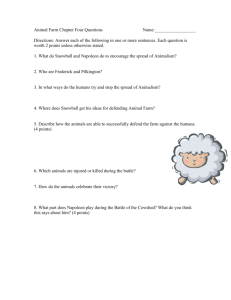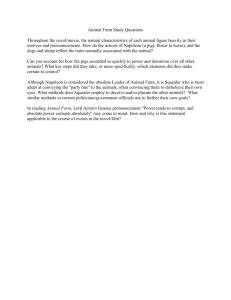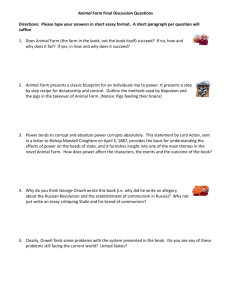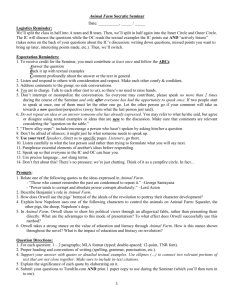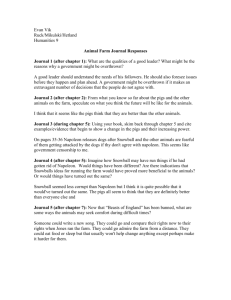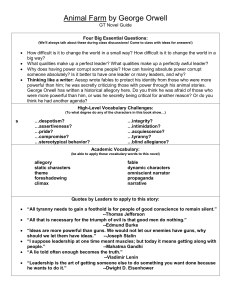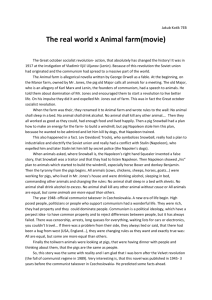Full title: Animal Farm: A Fairy Story
advertisement
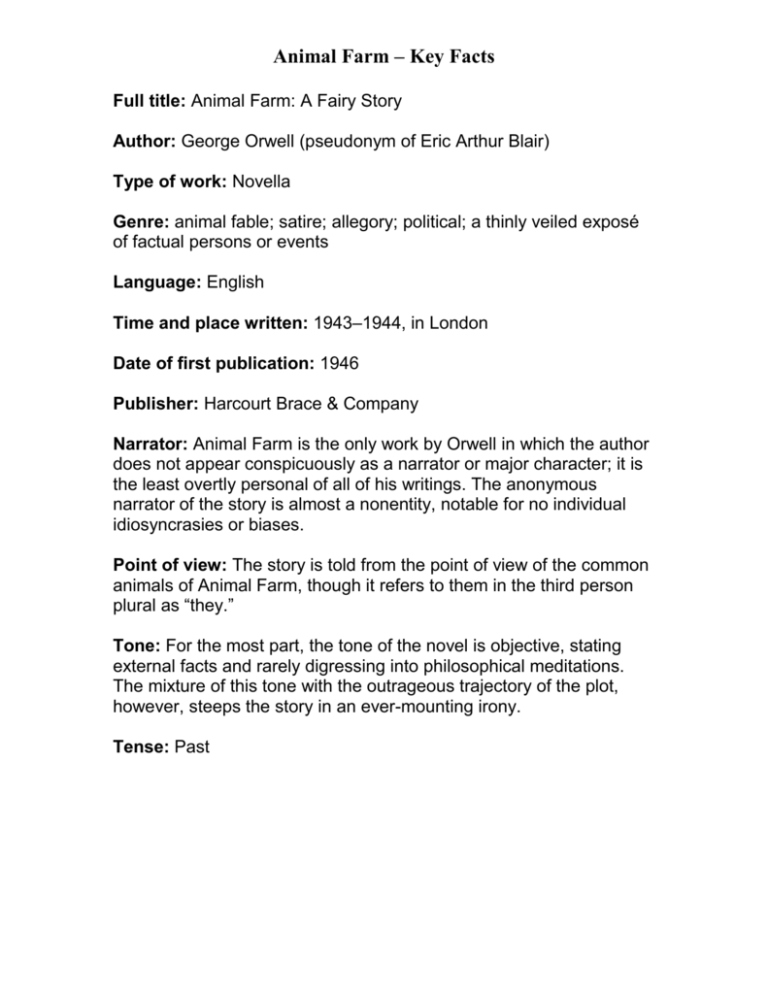
Animal Farm – Key Facts Full title: Animal Farm: A Fairy Story Author: George Orwell (pseudonym of Eric Arthur Blair) Type of work: Novella Genre: animal fable; satire; allegory; political; a thinly veiled exposé of factual persons or events Language: English Time and place written: 1943–1944, in London Date of first publication: 1946 Publisher: Harcourt Brace & Company Narrator: Animal Farm is the only work by Orwell in which the author does not appear conspicuously as a narrator or major character; it is the least overtly personal of all of his writings. The anonymous narrator of the story is almost a nonentity, notable for no individual idiosyncrasies or biases. Point of view: The story is told from the point of view of the common animals of Animal Farm, though it refers to them in the third person plural as “they.” Tone: For the most part, the tone of the novel is objective, stating external facts and rarely digressing into philosophical meditations. The mixture of this tone with the outrageous trajectory of the plot, however, steeps the story in an ever-mounting irony. Tense: Past Animal Farm – Key Facts Setting (time): As is the case with most fables, Animal Farm is set in an unspecified time period and is largely free from historical references that would allow the reader to date the action precisely. It is fair to assume, however, that Orwell means the fable to be contemporaneous with the object of its satire, the Russian Revolution (1917–1945). It is important to remember that this period represented the recent past and present at the time of writing and that Orwell understands the significance of the story’s action to be immediate and ongoing rather than historical. Setting (place): An imaginary farm in England Protagonist: [proh-tag-uh-nist -- the leading character, hero, or heroine of a drama or other literary work.] There is no clear central character in the novel, but Napoleon, the dictatorial pig, is the figure who drives and ties together most of the action. Major conflict: There are a number of conflicts in Animal Farm—the animals versus Mr. Jones, Snowball versus Napoleon, the common animals versus the pigs, Animal Farm versus the neighbouring humans—but all of them are expressions of the underlying tension between the exploited and exploiting classes and between the lofty ideals and harsh realities of socialism. Rising action: The animals throw off their human oppressors and establish a socialist state called Animal Farm; the pigs, being the most intelligent animals in the group, take control of the planning and government of the farm; Snowball and Napoleon engage in ideological disputes and compete for power. Climax: In Chapter V, Napoleon runs Snowball off the farm with his trained pack of dogs and declares that the power to make decisions for the farm will be exercised solely by the pigs. Falling action: Squealer emerges to justify Napoleon’s actions with skilful but duplicitous reinterpretations of Animalist principles; Napoleon continues to consolidate his power, eliminating his enemies and reinforcing his status as supreme leader; the common animals continue to obey the pigs, hoping for a better future. Animal Farm – Key Facts Themes: The corruption of socialist ideals in the Soviet Union; the societal tendency toward class stratification; the danger of a naive working class; the abuse of language as instrumental to the abuse of power Motifs: Songs; state ritual Symbols: Animal Farm; the barn; the windmill Foreshadowing · The pigs’ eventual abuse of power is foreshadowed at several points in the novel. At the end of Chapter II, immediately after the establishment of the supposedly egalitarian Animal Farm, the extra milk taken from the cows disappears, and the text implies that Napoleon has drunk it himself. Similarly, the dogs’ attack on Boxer during Napoleon’s purges, in Chapter VII, foreshadows the pigs’ eventual betrayal of the loyal cart-horse.
